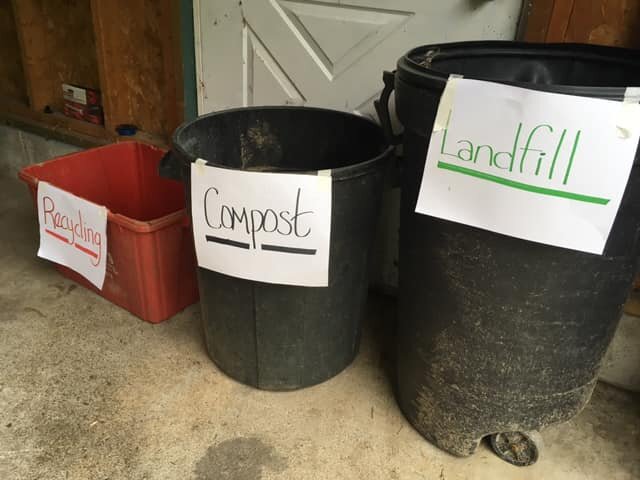Hosting a Lo-To-No Waste Outdoors Event
Outdoor events can generate large amounts of trash! This summer we intentionally set about to have lo-to-no waste events and we didn’t get it perfect but it was a great learning experience!
Here are some eco-friendly tips for camping, bar-b-ques, family reunions, and any other event that has a large number of folks cooking and eating outside. This approach will create a lot less landfill trash. If you don’t have a compost area set up or know of someone who does, check in with a nearby garden or farm to see if they will handle your scraps. (Just remember no meat, dairy or large amounts of oils should go in the compost.) Look at this as a learning experience and an experiment. This may be a very new situation for some and comfort levels will vary so providing a lot of options beforehand will help folks get in where they fit in.
10 Tips for Hosting Lo-To-No Waste Outdoor Events
Waste station setup. It doesn’t have to be complicated! We used a recycle bin and two large garbage cans labeled respectively: Recycling, Compost, and Landfill. Guests will do a lot better with signage that clearly indicates what can be composted and recycled.
Instead of single use plastics and paper goods, ask guests to BYO reusables for the meal such as a plate, bowl, cup, silverware, water bottle, cloth napkins or dish towels. This is sometimes referred to as a “feast bundle”. I attended a wedding earlier this year and we were asked to bring our own feast bundles. And to bring an extra one for that new friend you meet. It worked out very well!
Guests could also pack compostable dinnerware as an option. There are a number of reusable cutlery options available on-line if you don’t want to raid the silverware drawer. Some are better than others so do your homework and watch those dimensions so you don’t end up with doll size forks like I did. (see video below.)
Have some feast bundles and/or compostable dinnerware available for guests who need them. Compostable cutlery and dinnerware is now available at most big box stores and grocery store chains. Also check out what is available at Michigan Greensafe for your next partay.
Cook and serve in your own pots and pans. If guests are to being a dish to pass or share, encourage them to bring it in their own reusable dish (label it if necessary).
Make a dishwashing station for folks to handle their things. This is easily accomplished with three or four dishpans, an eco-friendly detergent, a few drops of bleach for sanitizing, and some dishcloths, sponges and drying rack or towels. Scrape all dishes as well as possible into the compost or landfill cans, pre-rinse in first basin, have some hot soapy water for the second basin (can be heated in a pot at the campfire, on the grill or a camp stove), and one or two for rinsing the cleaned dishes.
Have a hand-washing station and cooking water station as well. These can be handled with a water hose and/or various large water coolers.
Ask guests to bring their drinking water in gallon containers or larger, not the small individual bottles. Guests should also bring a refillable water bottle and/or reusable cups.
Burn it! If there are things such as paper towel, paper plates that are not compostable, cardboard from food packaging, etc. it can be burned as part of the campfire.
Try your best. Somethings are hard to part with when dining outdoors such as aluminum foil and zip-loc bags. There are (pricey) alternatives such as silicone mats and bags…but I’m not all that sure they are worth the investment yet. I just try to eliminate their use as much as possible in my home kitchen.
BONUS!! Above all, HAVE FUN! This can be an opportunity for deeper conversations around environmental issues but it can also be a fun challenge to see how little waste can be made.
Below is after one event of about 40 people…we didn’t do that bad! No matter what, awareness was increased.


